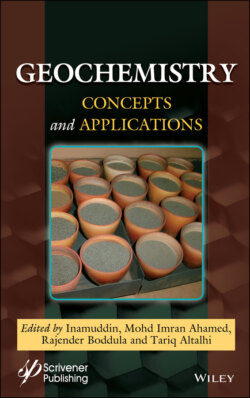Читать книгу Geochemistry - Группа авторов - Страница 10
1.2 Serpentinitic Geological Systems 1.2.1 Nature, Occurrence, and Geochemistry
ОглавлениеThe serpentine group consists of three minerals: (1) chrysotile, which is a type of asbestos; (2) antigorite; and (3) lizardite (www.minerals.net; www.geology.com). The hydrothermal transformation of ultramafic rocks or protoliths such pyroxenites and peridotites results in the formation of serpentines [9, 11]. In this chapter, the term serpentinitic geological systems is broadly used to refer to both serpentines sensu stricto, and their ultramafic protoliths or precursor rock assemblages. This is because both serpentines and their ultramafic protoliths contain anomalously high concentrations of toxic contaminants [4].
Serpentinitic geological systems are sparsely distributed across all continents, particularly along plate convergent boundaries such as Circum-Pacific margin [4]. Countries hosting significant serpentinitic geological systems include, the USA (California, Oregon), Spain, Australia (Western Australia), Sri Lanka and Zimbabwe (Great Dyke) [4, 12–15]. In Africa, the Great Dyke in Zimbabwe is linear ultramafic geological formation hosting serpentinitic geological systems and other associated petrological assemblages [4, 16, 17]. Serpentinitic geological systems have a unique geochemistry, defined by anomalously high concentrations of toxic contaminants [1]. Of human health concerns are high concentrations of chrysotile asbestos, toxic metals specifically Cr, Ni, Fe, Mn, Co, and Cd [1, 9], and potential enrichment of rare earth elements.
Toxic contaminants in serpentinitic geological systems are released via natural and anthropogenic activities. Natural processes include biotic and abiotic weathering processes, and subsequent erosion and mass movement [18]. Anthropogenic activities include agriculture (i.e., tillage practices) and mining operations including metallurgical processing, construction, and sculpturing, carving, and engraving [4]. Once released from the host rock toxic contaminants are widely disseminated via wind and hydrologically-mediated processes. These processes include surface and sub-surface runoff, water and wind erosion, infiltration and groundwater recharge, and surface water-groundwater exchanges [4]. Moreover, due to the low moisture retention and infiltration of serpentine soils, they are highly susceptible to high runoff, erosion and mass movement (e.g., landslides) [19]. Therefore, the toxic contaminants from serpentinitic geological systems tend to be widely disseminated into the surrounding environment, resulting in off-site environmental pollution and human health risks [4, 19].
